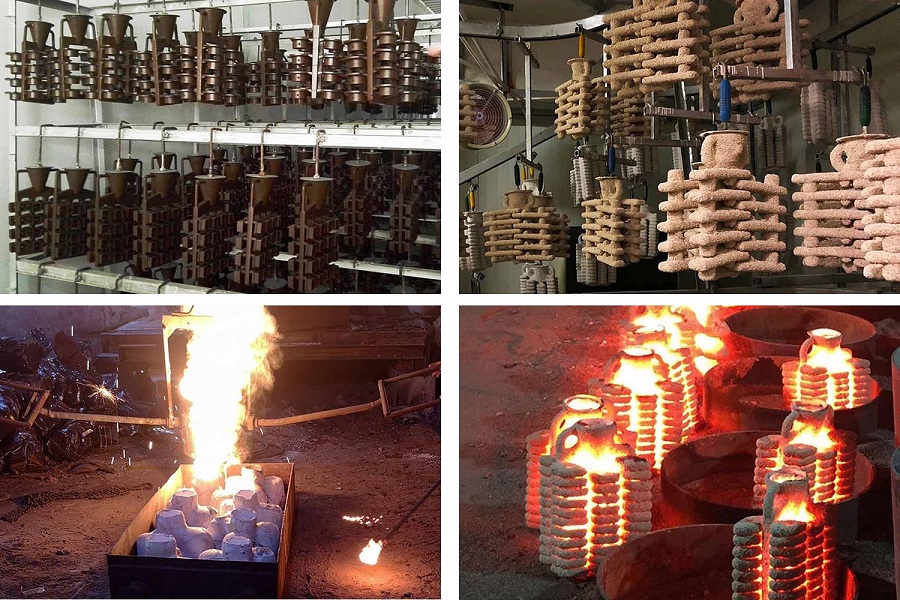
Silica Sol Investment Casting Stainless Steel Valve Disc
Material: Stainless Steel AISI 304 Process: Silica Sol Lost Wax Casting Weight: 4.85 KG Application: Butterfly Valve Disc
Silica sol is a typical water-based binder with a silicic acid colloid structure. It is a polymer colloidal solution in which highly dispersed silica particles are soluble in water. The colloidal particles are spherical and have a diameter of 6-100 nm.
Stainless Steel Silica Sol Lost Wax Casting Valve Disc
The dimensional tolerance level of investment castings can reach CT4 ~ CT7. Among them, the dimensional tolerance grades of cast steel investment castings, cast iron investment castings, nickel-based alloy investment castings and cobalt-based alloy investment castings are generally CT5 ~ CT7. The dimensional tolerance level of light metal and copper alloy investment castings can reach CT4 ~ CT6. The process of investment casting to make the shell is the process of gelling. There are many factors influencing gelation, mainly electrolyte, pH, sol concentration and temperature. There are many types of commercial silica sols, and the most used is alkaline silica sol with a silica content of 30%. Silica sol investment casting process is adopted by more and more foundries. Silica sol is a typical water-based binder with a silicic acid colloid structure. It is a polymer colloidal solution in which highly dispersed silica particles are soluble in water. The colloidal particles are spherical and have a diameter of 6-100 nm.
▶ Available Raw Materials for Investment Casting, Lost Wax Casting Process:
• Carbon Steel: AISI 1020 - AISI 1060,• Steel Alloys: ZG20SiMn, ZG30SiMn, ZG30CrMo, ZG35CrMo, ZG35SiMn, ZG35CrMnSi, ZG40Mn, ZG40Cr, ZG42Cr, ZG42CrMo...etc on request.
• Stainless Steel: AISI 304, AISI 304L, AISI 316, AISI 316L, 1.4404, 1.4301 and other stainless steel grade.
• Brass & Copper.
• Other Materials and Standards on request
▶ Capabilities of Investment Casting Foundry
• Max Size: 1,000 mm × 800 mm × 500 mm• Weight Range: 0.5 kg - 100 kg
• Annual Capacity: 2,000 tons
• Bond Materials for Shell Building: Silica Sol, Water Glass and their mixtures.
• Tolerances: On Request.
▶ Main Production Procedure
• Patterns & Tooling Design → Metal Die Making → Wax Injection → Slurry Assembly → Shell Building → De-Waxing → Chemical Composition Analysis → Melting & Pouring → Cleaning, Grinding & Shot Blasting → Post Processing or Packing for Shipment▶ Inspecting Lost Wax Castings
• Spectrographic and manual quantitative analysis• Metallographic analysis
• Brinell, Rockwell and Vickers hardness inspection
• Mechanical property analysis
• Low and normal temperature impact testing
• Cleanliness inspection
• UT, MT and RT inspection
▶ Post-Casting Process
• Deburring & Cleaning• Shot Blasting / Sand Peening
• Heat Treatment: Normalization, Quench, Tempering, Carburization, Nitriding
• Surface Treatment: Passivation, Anodizing, Electroplating, Hot Zinc Plating, Zinc Plating, Nickel Plating, Polishing, Electro-Polishing, Painting, GeoMet, Zintec.
• Machining: Turning, Milling, Lathing, Drilling, Honing, Grinding.
Investment casting molds are currently generally used in a shell made of multilayer refractory materials. After the module is dipped and coated with refractory coating, sprinkle the granular refractory material, and then dry and harden, and repeat this process many times until the refractory material layer reaches the required thickness. The properties of the shell are closely related to the materials used in the shell making and the shell making process. Shell materials include refractory materials, binders, solvents, hardeners, surfactants, etc. Among them, the refractory material and the binder directly form the shell, which is the main shell material. The refractory materials used in investment casting are mainly silica sand, corundum and aluminosilicate refractories (such as refractory clay and aluminum banadium, etc.).
The coating shell prepared with water glass is easy to deform and crack. Compared with ethyl silicate, the castings produced have low dimensional accuracy and high surface roughness. Water glass binder is suitable for the production of small ordinary steel castings and non-ferrous alloy castings. Water glass for investment casting usually has a modulus of 3.0~3.4 and a density of 1.27~1.34 g/cm3. Silica sol binder is an aqueous solution of silicic acid, also known as silica sol. Its price is 1/3~1/2 lower than that of ethyl silicate. The quality of castings produced by using silica sol as a binder is higher than that of water glass. The binding agent has been greatly improved. Silica sol has good stability and can be stored for a long time. It does not require special hardeners when making shells.
The high temperature strength of the shell of solica sol is better than that of ethyl silicate shells, but the silica sol has poor wettability to the investment and takes longer to harden. The main processes of shell making include module degreasing, coating and sanding, drying and hardening, demoulding and roasting. As a kind of precision casting process, the investment casting which uses silica solution and water glass bonded casting or their combined bond as shell building materials are the mostly used in RMC Casting Foundry to produce carbon steel castings.
Different precision casting process are also available based on the required precision grade of the casting parts. For example, water glass and silica sol combined investment casting process could be used for low or middle precision grade steel castings, while the silica sol casting processes have to be used for stainless steel castings with required precision grade.

 русский
русский




